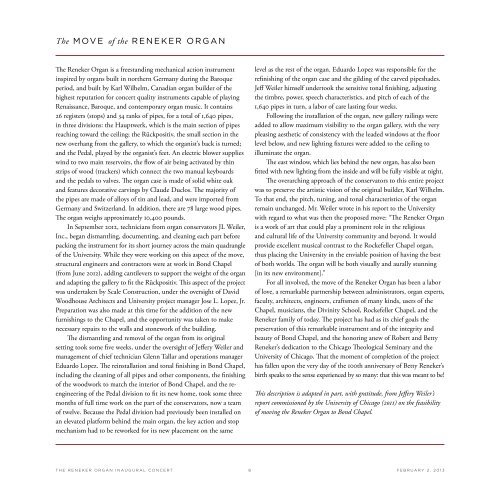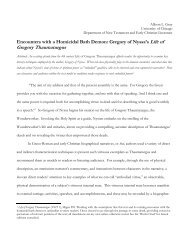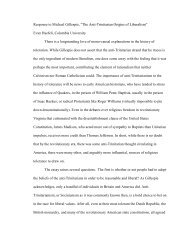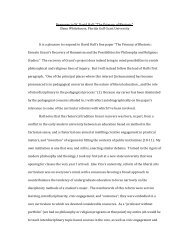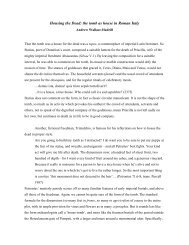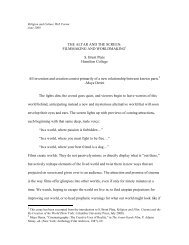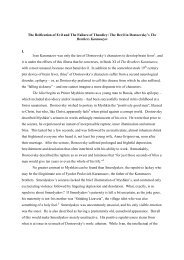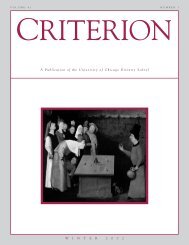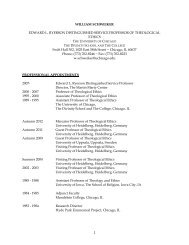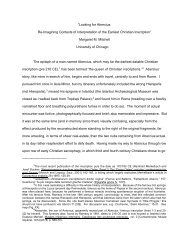Click here - Divinity School - University of Chicago
Click here - Divinity School - University of Chicago
Click here - Divinity School - University of Chicago
You also want an ePaper? Increase the reach of your titles
YUMPU automatically turns print PDFs into web optimized ePapers that Google loves.
The MOVE <strong>of</strong> the RENEK E R ORGAN<br />
The Reneker Organ is a freestanding mechanical action instrument<br />
inspired by organs built in northern Germany during the Baroque<br />
period, and built by Karl Wilhelm, Canadian organ builder <strong>of</strong> the<br />
highest reputation for concert quality instruments capable <strong>of</strong> playing<br />
Renaissance, Baroque, and contemporary organ music. It contains<br />
26 registers (stops) and 34 ranks <strong>of</strong> pipes, for a total <strong>of</strong> 1,640 pipes,<br />
in three divisions: the Hauptwerk, which is the main section <strong>of</strong> pipes<br />
reaching toward the ceiling; the Rückpositiv, the small section in the<br />
new overhang from the gallery, to which the organist’s back is turned;<br />
and the Pedal, played by the organist’s feet. An electric blower supplies<br />
wind to two main reservoirs, the flow <strong>of</strong> air being activated by thin<br />
strips <strong>of</strong> wood (trackers) which connect the two manual keyboards<br />
and the pedals to valves. The organ case is made <strong>of</strong> solid white oak<br />
and features decorative carvings by Claude Duclos. The majority <strong>of</strong><br />
the pipes are made <strong>of</strong> alloys <strong>of</strong> tin and lead, and were imported from<br />
Germany and Switzerland. In addition, t<strong>here</strong> are 78 large wood pipes.<br />
The organ weighs approximately 10,400 pounds.<br />
In September 2012, technicians from organ conservators JL Weiler,<br />
Inc., began dismantling, documenting, and cleaning each part before<br />
packing the instrument for its short journey across the main quadrangle<br />
<strong>of</strong> the <strong>University</strong>. While they were working on this aspect <strong>of</strong> the move,<br />
structural engineers and contractors were at work in Bond Chapel<br />
(from June 2012), adding cantilevers to support the weight <strong>of</strong> the organ<br />
and adapting the gallery to fit the Rückpositiv. This aspect <strong>of</strong> the project<br />
was undertaken by Scale Construction, under the oversight <strong>of</strong> David<br />
Woodhouse Architects and <strong>University</strong> project manager Jose L. Lopez, Jr.<br />
Preparation was also made at this time for the addition <strong>of</strong> the new<br />
furnishings to the Chapel, and the opportunity was taken to make<br />
necessary repairs to the walls and stonework <strong>of</strong> the building.<br />
The dismantling and removal <strong>of</strong> the organ from its original<br />
setting took some five weeks, under the oversight <strong>of</strong> Jeffery Weiler and<br />
management <strong>of</strong> chief technician Glenn Tallar and operations manager<br />
Eduardo Lopez. The reinstallation and tonal finishing in Bond Chapel,<br />
including the cleaning <strong>of</strong> all pipes and other components, the finishing<br />
<strong>of</strong> the woodwork to match the interior <strong>of</strong> Bond Chapel, and the reengineering<br />
<strong>of</strong> the Pedal division to fit its new home, took some three<br />
months <strong>of</strong> full time work on the part <strong>of</strong> the conservators, now a team<br />
<strong>of</strong> twelve. Because the Pedal division had previously been installed on<br />
an elevated platform behind the main organ, the key action and stop<br />
mechanism had to be reworked for its new placement on the same<br />
level as the rest <strong>of</strong> the organ. Eduardo Lopez was responsible for the<br />
refinishing <strong>of</strong> the organ case and the gilding <strong>of</strong> the carved pipeshades.<br />
Jeff Weiler himself undertook the sensitive tonal finishing, adjusting<br />
the timbre, power, speech characteristics, and pitch <strong>of</strong> each <strong>of</strong> the<br />
1,640 pipes in turn, a labor <strong>of</strong> care lasting four weeks.<br />
Following the installation <strong>of</strong> the organ, new gallery railings were<br />
added to allow maximum visibility to the organ gallery, with the very<br />
pleasing aesthetic <strong>of</strong> consistency with the leaded windows at the floor<br />
level below, and new lighting fixtures were added to the ceiling to<br />
illuminate the organ.<br />
The east window, which lies behind the new organ, has also been<br />
fitted with new lighting from the inside and will be fully visible at night.<br />
The overarching approach <strong>of</strong> the conservators to this entire project<br />
was to preserve the artistic vision <strong>of</strong> the original builder, Karl Wilhelm.<br />
To that end, the pitch, tuning, and tonal characteristics <strong>of</strong> the organ<br />
remain unchanged. Mr. Weiler wrote in his report to the <strong>University</strong><br />
with regard to what was then the proposed move: “The Reneker Organ<br />
is a work <strong>of</strong> art that could play a prominent role in the religious<br />
and cultural life <strong>of</strong> the <strong>University</strong> community and beyond. It would<br />
provide excellent musical contrast to the Rockefeller Chapel organ,<br />
thus placing the <strong>University</strong> in the enviable position <strong>of</strong> having the best<br />
<strong>of</strong> both worlds. The organ will be both visually and aurally stunning<br />
[in its new environment].”<br />
For all involved, the move <strong>of</strong> the Reneker Organ has been a labor<br />
<strong>of</strong> love, a remarkable partnership between administrators, organ experts,<br />
faculty, architects, engineers, craftsmen <strong>of</strong> many kinds, users <strong>of</strong> the<br />
Chapel, musicians, the <strong>Divinity</strong> <strong>School</strong>, Rockefeller Chapel, and the<br />
Reneker family <strong>of</strong> today. The project has had as its chief goals the<br />
preservation <strong>of</strong> this remarkable instrument and <strong>of</strong> the integrity and<br />
beauty <strong>of</strong> Bond Chapel, and the honoring anew <strong>of</strong> Robert and Betty<br />
Reneker’s dedication to the <strong>Chicago</strong> Theological Seminary and the<br />
<strong>University</strong> <strong>of</strong> <strong>Chicago</strong>. That the moment <strong>of</strong> completion <strong>of</strong> the project<br />
has fallen upon the very day <strong>of</strong> the 100th anniversary <strong>of</strong> Betty Reneker’s<br />
birth speaks to the sense experienced by so many: that this was meant to be!<br />
This description is adapted in part, with gratitude, from Jeffery Weiler’s<br />
report commissioned by the <strong>University</strong> <strong>of</strong> <strong>Chicago</strong> (2011) on the feasibility<br />
<strong>of</strong> moving the Reneker Organ to Bond Chapel.<br />
THE RENEKER OR GAN INAUGUR AL CO N C E RT 8 FEBR UAR Y 2, 2013


